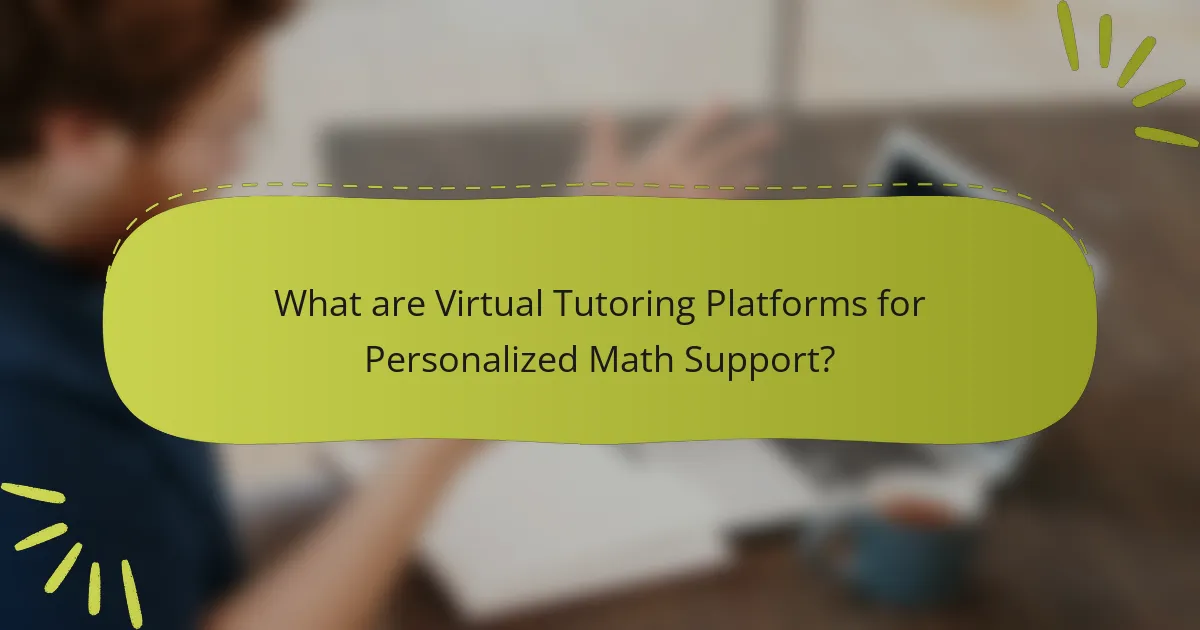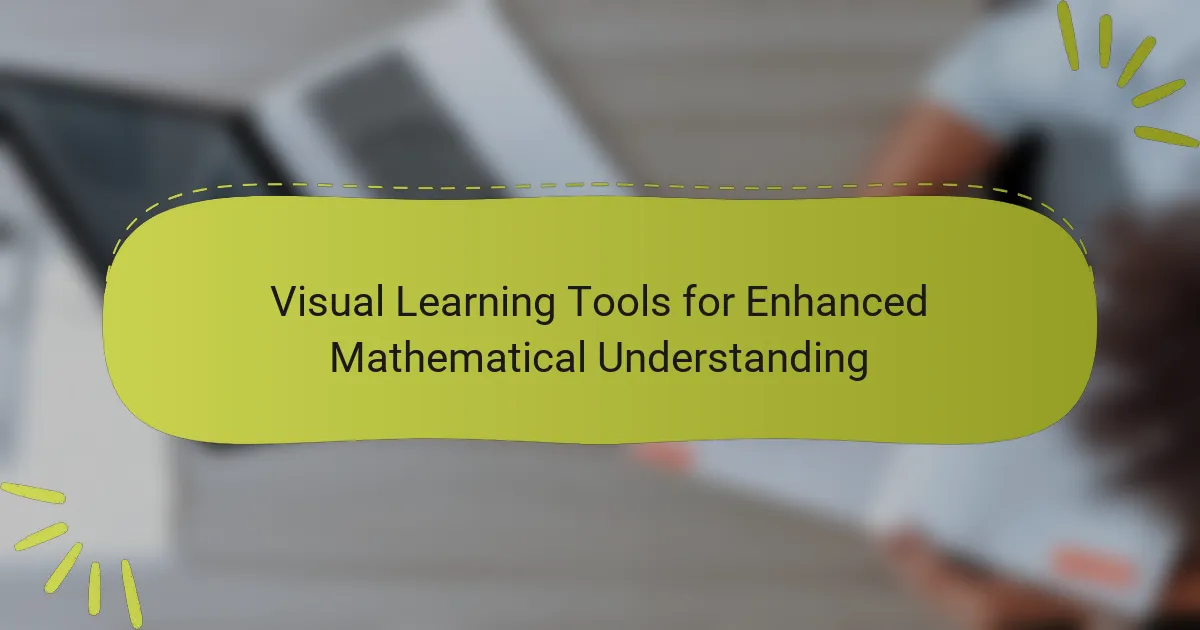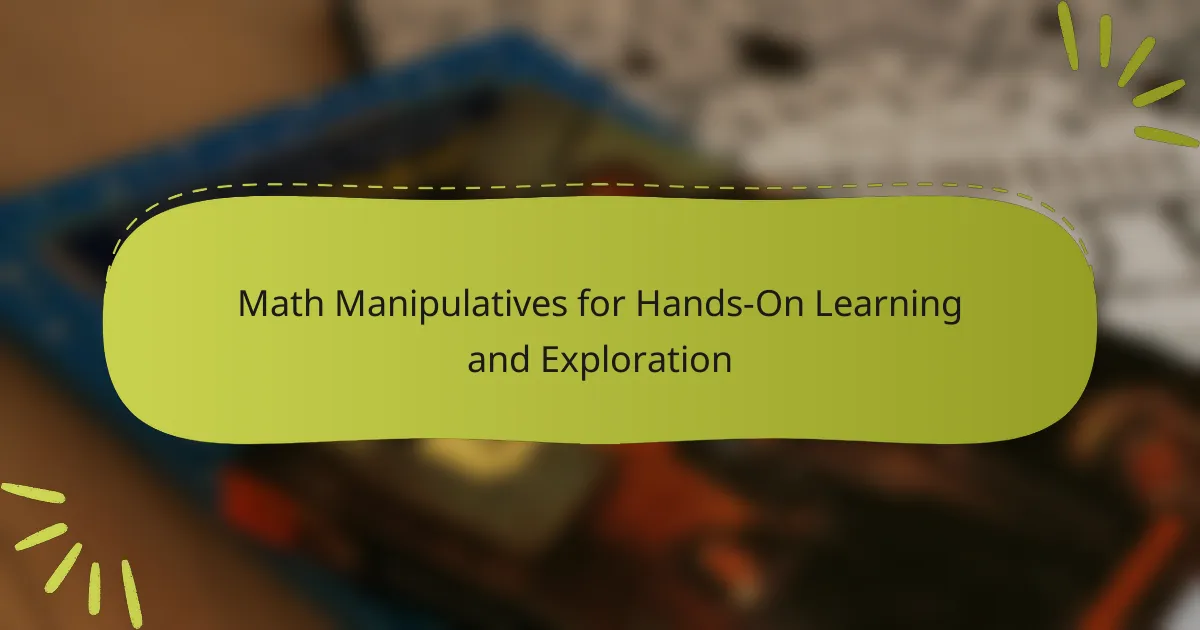Virtual tutoring platforms are online services designed to provide personalized math support by connecting students with tutors for individualized instruction. These platforms offer tailored learning experiences that adapt to each student’s unique needs and learning pace, featuring one-on-one video sessions, interactive problem-solving, and progress tracking. Utilizing adaptive learning technologies, platforms like Khan Academy and Tutor.com adjust content difficulty in real-time to enhance comprehension. Research indicates that personalized tutoring significantly boosts student performance in math, with studies showing higher standardized test scores among students who receive this specialized support compared to their peers.

What are Virtual Tutoring Platforms for Personalized Math Support?
Virtual tutoring platforms for personalized math support are online services that connect students with tutors for individualized math instruction. These platforms offer tailored learning experiences based on the student’s unique needs and learning pace. They typically include features such as one-on-one video sessions, interactive problem-solving, and progress tracking. Many platforms utilize adaptive learning technologies to adjust content difficulty in real-time. For example, platforms like Khan Academy and Tutor.com provide resources that cater to various learning styles. Studies show that personalized tutoring can significantly improve student performance in math. According to a report by the National Bureau of Economic Research, students receiving personalized tutoring scored higher on standardized tests compared to those who did not.
How do Virtual Tutoring Platforms enhance math learning?
Virtual tutoring platforms enhance math learning by providing personalized instruction tailored to individual student needs. These platforms utilize adaptive learning technologies to assess a student’s proficiency and adjust the curriculum accordingly. Real-time feedback helps students understand their mistakes and correct them immediately. Access to a variety of resources, such as interactive exercises and video tutorials, supports diverse learning styles. Moreover, one-on-one sessions with experienced tutors foster a deeper understanding of complex concepts. According to a study by the Bill & Melinda Gates Foundation, personalized learning can lead to significant improvements in student outcomes. This evidence highlights the effectiveness of virtual tutoring in enhancing math learning.
What features do these platforms typically include?
Virtual tutoring platforms for personalized math support typically include features such as interactive whiteboards. These allow real-time collaboration between tutors and students. Many platforms also offer video conferencing tools for face-to-face interaction. Additionally, they often provide access to a library of resources and practice materials. Some platforms include assessment tools to track student progress. Others feature scheduling systems for booking sessions easily. User-friendly interfaces enhance navigation and accessibility. Finally, many platforms support multiple devices, enabling learning on-the-go.
How do these features cater to different learning styles?
Virtual tutoring platforms for personalized math support cater to different learning styles by offering diverse instructional methods. These platforms provide visual aids, such as graphs and diagrams, which assist visual learners. They also include interactive problem-solving sessions for kinesthetic learners who benefit from hands-on activities. Additionally, auditory learners can engage through recorded lectures and verbal explanations.
The adaptability of these platforms allows for personalized pacing, accommodating learners who require more time or those who grasp concepts quickly. According to research by the International Society for Technology in Education, tailored learning experiences enhance understanding and retention across various learning styles. This evidence supports the effectiveness of virtual tutoring features in addressing individual educational needs.
Why is personalized math support important?
Personalized math support is important because it addresses individual learning needs. Each student has unique strengths and weaknesses in math. Tailored instruction can help bridge gaps in understanding. Research shows that personalized learning improves student performance. A study by the Bill & Melinda Gates Foundation found that students using personalized learning approaches showed higher achievement levels. Additionally, personalized support boosts student confidence and engagement. Engaged students are more likely to persist in challenging subjects. Overall, personalized math support leads to better educational outcomes.
How does personalized support impact student performance?
Personalized support significantly enhances student performance. Tailored assistance addresses individual learning needs. It fosters engagement and motivation among students. A study by the Bill & Melinda Gates Foundation found that personalized learning can lead to a 30% increase in student achievement. This approach allows for real-time feedback and adaptive learning paths. Students receive support that matches their pace and style. As a result, they develop a deeper understanding of concepts. Personalized support leads to improved academic outcomes and higher retention rates.
What are the psychological benefits of personalized learning?
Personalized learning enhances student motivation and engagement. It allows learners to progress at their own pace. This tailored approach meets individual needs and learning styles. Research shows that personalized learning can lead to improved self-efficacy. A study by the Bill & Melinda Gates Foundation found that students in personalized learning environments reported higher levels of confidence. Additionally, personalized learning fosters a sense of ownership over the learning process. This empowerment can reduce anxiety and increase resilience in students. Overall, these psychological benefits contribute to better academic outcomes.
What types of Virtual Tutoring Platforms are available?
There are several types of virtual tutoring platforms available. These platforms can be categorized into live tutoring, on-demand tutoring, and self-paced learning systems. Live tutoring platforms offer real-time interaction between tutors and students. Examples include Zoom-based sessions or platforms like Wyzant. On-demand tutoring platforms provide instant access to tutors whenever needed. Services like Chegg Tutors exemplify this model. Self-paced learning systems allow students to learn at their own speed using pre-recorded materials. Platforms such as Khan Academy fall into this category. Each type serves distinct learning preferences and needs.
What distinguishes live tutoring from asynchronous tutoring?
Live tutoring occurs in real-time, allowing immediate interaction between tutor and student. This format enables instant feedback and clarification of concepts. In contrast, asynchronous tutoring allows students to access materials and complete assignments at their convenience. Students can learn at their own pace without real-time interaction. Live tutoring fosters a dynamic learning environment, while asynchronous tutoring promotes flexibility. Research indicates that students often retain information better with immediate feedback, supporting the effectiveness of live tutoring.
How do subscription-based platforms differ from pay-per-session models?
Subscription-based platforms provide access to services for a recurring fee. Users pay a flat rate, often monthly or annually, for unlimited access to resources. This model encourages ongoing learning and engagement. In contrast, pay-per-session models charge users for each individual session. Users pay only when they access a service, which may lead to less frequent usage. Subscription models often include additional features like resources and community support. Pay-per-session models typically focus solely on the tutoring session itself. Research indicates that subscription models can lead to higher user retention rates due to their structure.
How do Virtual Tutoring Platforms work?
Virtual tutoring platforms connect students with tutors through online interfaces. These platforms typically offer features like video conferencing, chat, and interactive whiteboards. Students can schedule sessions based on their availability. Tutors provide personalized instruction tailored to the student’s needs. The platforms often include assessment tools to track progress. Many use algorithms to match students with suitable tutors. This ensures effective learning experiences. Research shows that online tutoring can improve academic performance significantly.
What technology underpins these platforms?
Virtual tutoring platforms for personalized math support are primarily underpinned by artificial intelligence (AI) and machine learning technologies. These technologies allow for adaptive learning experiences tailored to individual student needs. AI algorithms analyze student performance data in real-time. This analysis helps in customizing lesson plans and providing targeted feedback. Additionally, natural language processing (NLP) enables effective communication between students and tutors. Cloud computing facilitates accessibility and scalability of these platforms. This infrastructure supports simultaneous user interactions without performance degradation. Overall, these technologies create an interactive and efficient learning environment for students seeking math support.
How do users interact with tutors on these platforms?
Users interact with tutors on virtual tutoring platforms primarily through live chat, video calls, and messaging. These platforms offer real-time communication tools that facilitate discussions and feedback. Users can schedule sessions based on their availability. During sessions, users can ask questions and receive immediate responses. Tutors can share screens to explain concepts visually. Users can also access recorded sessions for later review. Many platforms provide interactive tools, such as whiteboards, for collaborative problem-solving. Feedback and progress tracking are often integrated into the platform, enhancing the learning experience.
What challenges do users face with Virtual Tutoring Platforms?
Users face several challenges with virtual tutoring platforms. Technical issues often hinder effective communication. Users may experience connectivity problems or software glitches. These issues can disrupt learning sessions and cause frustration. Additionally, the lack of personalized interaction can make it difficult for students to engage fully. Some platforms may not provide tailored support for individual learning needs. Users also report challenges with scheduling and availability of tutors. Time zone differences can complicate session planning. Lastly, the effectiveness of virtual learning may vary based on the student’s self-discipline and motivation. Research indicates that these factors can significantly impact the overall success of online tutoring experiences.
How can technical issues affect the learning experience?
Technical issues can significantly disrupt the learning experience on virtual tutoring platforms. These issues can include poor internet connectivity, software glitches, and hardware malfunctions. Poor internet connectivity can lead to lagging video and audio, making communication difficult. Software glitches may cause interruptions in accessing learning materials or tools. Hardware malfunctions can prevent students from using necessary devices, such as computers or tablets. According to a study by the University of Southern California, 70% of students reported that technical difficulties hindered their online learning. This evidence shows that technical issues can lead to frustration and decreased engagement in the learning process.
What common obstacles do students encounter in virtual tutoring?
Students encounter several common obstacles in virtual tutoring. Technical issues are prevalent, including poor internet connectivity and software malfunctions. These can disrupt the learning experience and hinder communication. Another challenge is the lack of personal interaction. Students may struggle with engagement and motivation without face-to-face contact. Additionally, students often face distractions at home. This environment can reduce focus and productivity during sessions. Time zone differences can also complicate scheduling, especially for international tutoring. Lastly, varying levels of digital literacy among students can create barriers to effective learning. These obstacles can significantly impact the overall effectiveness of virtual tutoring.
What are the best practices for using Virtual Tutoring Platforms effectively?
To use virtual tutoring platforms effectively, establish clear learning goals. Define specific objectives for each session. Choose a platform that aligns with the student’s needs. Ensure it offers interactive tools for engagement. Schedule regular sessions to maintain consistency. Create a distraction-free environment for focused learning. Encourage open communication between the tutor and student. Utilize feedback to adjust learning strategies. These practices enhance the overall effectiveness of virtual tutoring.
How can students maximize their learning outcomes?
Students can maximize their learning outcomes by actively engaging with virtual tutoring platforms. These platforms provide personalized math support tailored to individual learning styles. Students should set specific learning goals to guide their progress. Regular practice through interactive exercises enhances retention and understanding. Utilizing feedback from tutors helps identify areas for improvement. Engaging in collaborative learning with peers fosters deeper comprehension. Research indicates that personalized instruction can lead to significant gains in academic performance. A study by the Bill & Melinda Gates Foundation found that students using personalized learning approaches improved their math scores by 15%.
What tips can parents follow to support their children in virtual tutoring?
Parents can support their children in virtual tutoring by creating a dedicated learning space. This space should be quiet, well-lit, and free from distractions. Parents should also establish a consistent schedule for tutoring sessions. Regular routines help children stay focused and organized.
Engaging with the tutor can be beneficial. Parents should communicate with the tutor about their child’s progress and areas needing improvement. Encouraging active participation during sessions is essential. Parents can motivate their children to ask questions and engage in discussions.
Monitoring screen time is important. Parents should ensure that their children take breaks to avoid fatigue. Providing necessary materials in advance can facilitate smoother tutoring sessions. Lastly, celebrating achievements, no matter how small, boosts children’s confidence and motivation.
Virtual tutoring platforms for personalized math support are online services that connect students with tutors for individualized instruction, enhancing math learning through tailored experiences. These platforms utilize adaptive learning technologies, interactive tools, and real-time feedback to cater to diverse learning styles and needs. Key features include one-on-one video sessions, progress tracking, and a variety of resources to facilitate understanding. Research indicates that personalized tutoring significantly improves student performance and confidence in math, making these platforms an effective solution for addressing individual educational challenges.



